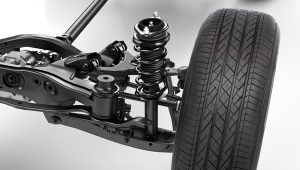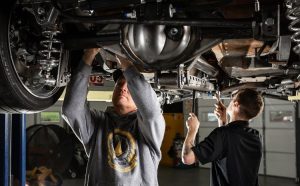Your car’s suspension is designed to carry a specific amount of weight safely and efficiently. When you exceed that limit — whether by loading heavy cargo, towing beyond your vehicle’s capacity, or carrying too many passengers — your suspension system suffers the consequences. Overloading doesn’t just reduce ride comfort; it can cause severe mechanical damage, unsafe handling, and premature wear on key components.
In this article, we’ll explore how overloading stresses the suspension system, the telltale signs that your car is carrying too much weight, and what you can do to prevent costly damage.
Understanding How Suspension Handles Weight

A suspension system’s primary purpose is to support the vehicle’s weight while maintaining stability, comfort, and tire contact with the road. It absorbs shocks from bumps, maintains even ride height, and distributes loads between the front and rear axles.
When you overload a vehicle, the suspension is forced beyond its designed parameters. Components such as springs, shocks, and control arms experience excessive compression and strain, which can lead to deformation, leaks, or complete failure.
Key Components Affected by Overloading:
| Component | Function | Effect of Overload |
|---|---|---|
| Springs (coil or leaf) | Support vehicle weight and maintain height | Permanent sagging, cracking, or breakage |
| Shock absorbers / struts | Control motion and damping | Leaks, overheating, loss of damping ability |
| Bushings and mounts | Isolate vibrations, allow movement | Premature cracking, noise, and misalignment |
| Ball joints and control arms | Maintain wheel alignment and geometry | Excess wear, steering instability |
| Tires | Maintain grip and load support | Uneven wear, blowouts, or sidewall cracking |
Even a small amount of excess weight can accelerate wear dramatically, especially when sustained over long trips or poor road conditions.
Common Causes of Suspension Overload
Many drivers unintentionally overload their vehicles without realizing it. Here are the most frequent causes:
-
Carrying excessive luggage or tools – Common in family trips or work vehicles.
-
Towing beyond rated capacity – Overweight trailers or equipment put extreme strain on rear suspension.
-
Uneven weight distribution – Heavy cargo placed over one side or axle.
-
Aftermarket modifications – Roof racks, bull bars, or custom interiors add unseen weight.
-
Old or weakened springs – Reduced capacity makes even normal loads stressful.
Always check your vehicle’s Gross Vehicle Weight Rating (GVWR) and payload capacity (listed in the owner’s manual or door jamb label) before loading.
Telltale Signs of an Overloaded Suspension
Ignoring overload symptoms can lead to dangerous handling and expensive repairs. Below are the most common indicators that your suspension is overstressed:
A. Noticeable Sagging
If your car’s rear (or sometimes front) sits visibly lower than usual, the springs are compressed beyond their limit. This sagging reduces ground clearance and affects handling balance.
B. Excessive Bouncing
Overloaded shocks and struts lose the ability to control rebound. If your car bounces repeatedly after going over a bump, it’s a classic sign of worn or overstressed dampers.
C. Unstable Handling or Steering
When weight shifts excessively during turns or braking, it strains bushings and joints, leading to vague steering, understeer, or oversteer.
D. Strange Noises
Creaking, clunking, or metallic knocks often signal that suspension mounts, bushings, or control arms are overstressed or misaligned.
E. Uneven or Rapid Tire Wear
Excessive load causes uneven tire contact with the road. You may see bald patches, outer-edge wear, or sidewall cracks — all indicators of suspension misalignment.
F. Longer Braking Distance
Overload increases braking distance because weight transfer and tire grip are affected. This also adds stress to shocks and bushings that must stabilize braking forces.
Comparing Normal vs. Overloaded Suspension Behavior
| Parameter | Normal Load | Overloaded Condition |
|---|---|---|
| Ride Height | Even and level | Sagging at rear or uneven stance |
| Ride Comfort | Smooth, controlled | Harsh or bouncy ride |
| Handling | Stable during turns | Excess body roll, understeer |
| Shock Absorber Response | Quick damping | Slow rebound, oscillation |
| Tire Condition | Even tread wear | Uneven or excessive edge wear |
| Noise Level | Minimal | Creaking, clunking, or groaning |
| Braking Performance | Balanced | Longer stopping distance |
If multiple signs from the overloaded column apply to your vehicle, it’s time to lighten the load or inspect your suspension.
Consequences of Ignoring Overload Stress
Continuing to drive an overloaded vehicle can lead to:
-
Broken or sagging springs – Loss of proper ride height and alignment.
-
Blown shock absorbers – Fluid leaks and total loss of damping.
-
Bent control arms or damaged bushings – Misalignment and poor steering control.
-
Accelerated tire wear – Costly replacements and reduced safety.
-
Frame or chassis damage – Especially in trucks or SUVs used for towing.
The combined result is unsafe handling, poor comfort, and potentially catastrophic mechanical failure.
Preventing Suspension Overstress
Simple steps to protect your suspension from overloading damage:
-
Know your limits: Check GVWR, axle ratings, and payload capacity.
-
Distribute weight evenly: Avoid placing all heavy cargo in one spot.
-
Use load-assist accessories: Air springs, helper springs, or heavy-duty shocks can improve load handling.
-
Monitor tire pressure: Inflate tires according to load ratings.
-
Inspect regularly: Look for sagging, leaks, and worn bushings.
-
Unload unnecessary gear: Every kilogram counts, especially on long trips.
When to Replace Worn Suspension Components
Once damage occurs, restoring handling and safety requires replacement of affected parts.
| Component | Common Failure Sign | Recommended Action |
|---|---|---|
| Springs | Vehicle sagging, uneven stance | Replace both springs on same axle |
| Shock Absorbers / Struts | Leaking fluid, excessive bouncing | Replace in pairs |
| Bushings / Mounts | Creaking, vibration | Replace with OEM or polyurethane versions |
| Ball Joints | Clunking over bumps | Replace immediately for safety |
| Control Arms | Misalignment, uneven tire wear | Replace or rebuild suspension geometry |
For durable and reliable parts designed to handle demanding conditions, you can
Buy Suspension online
and find coil springs, shocks, mounts, and rear suspension kits suitable for your vehicle.
Pro Tip: Recognize “Silent” Damage Early

Even if your car appears fine after heavy loading, microscopic fatigue can already be developing. Check for:
-
Fine cracks in rubber bushings
-
Leaking struts or dampers
-
Rust rings on spring coils
-
Worn bump stops or mounts
These early warning signs help prevent major failures later.
Final Thoughts
Your suspension is the unsung hero that keeps your car stable, safe, and comfortable — but it’s not indestructible. Overloading pushes it past its limits, leading to costly repairs and unsafe driving conditions.
By recognizing the signs of suspension overstress — sagging, instability, noise, and uneven wear — and practicing load-conscious driving, you can protect your vehicle’s integrity for years to come.
If damage has already occurred or components show wear, don’t delay repairs. Quality replacement parts are readily available — simply Buy Suspension online to restore your car’s comfort, safety, and handling performance.
A well-maintained suspension not only enhances driving pleasure but also ensures that every trip — whether light or heavy — remains smooth, stable, and safe.